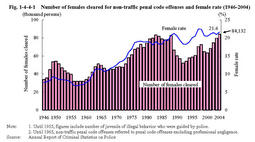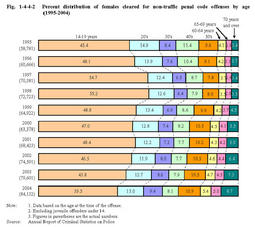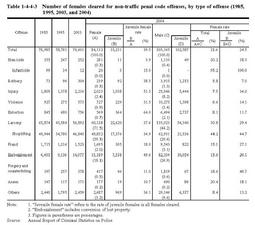| Previous Next Index Image Index Year Selection | |
|
|
1 Penal code offenses Fig.1-4-4-1 shows the number of females cleared for non-traffic penal code offenses and the female rate since1946.
Female cleared rate per100,000population aged14or over for non-traffic penal code offenses had been between100and130since1989,but continued to increase since2001,reaching146.7(up by7.5points from the previous year)in2004(see Appendix1-1 ). Fig.1-4-4-1 Number of females cleared for non-traffic penal code offenses and female rate(1946-2004) Fig.1-4-4-2 shows the percent distribution of females cleared for non-traffic penal code offenses by age over the last10years.Fig.1-4-4-2 Percent distribution of females cleared for non-traffic penal code offenses by age(1995-2004) Table1-4-4-3 shows the number of females cleared for non-traffic penal code offenses in2004,by type of offense,compared with1985,1995,and2003.In2004,females cleared for larceny accounted for the majority at71.5%,followed by embezzlement(18.1%)and injury(2.4%).More specifically,approximately80%of those cleared for larceny committed shoplifting and most of those cleared for embezzlement committed conversion of lost property. The female rate was high for infanticide in homicide(95.2%)and shoplifting in larceny(44.2%). The juvenile rate in all females cleared for non-traffic penal code offenses was extremely high for such offenses as extortion(64.0%),injury(51.3%),and embezzlement(49.6%). Table1-4-4-3 Number of females cleared for non-traffic penal code offenses,by type of offense(1985,1995,2003,and2004) |


